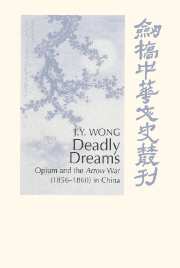Book contents
- Frontmatter
- Contents
- List of Tables
- List of Figures
- Poem by the late Mr Qin Esheng
- Foreword by Professor Wang Gungwu
- Foreword by Professor C. A. Bayly
- Preface
- Part I The confusion of imperialism
- Part II The pretext for imperialism
- Part III The personalities of imperialism
- Part IV The rhetoric of imperialism
- Part V The mechanics of imperialism
- Part VI The economics of imperialism
- Part VII The dynamics of imperialism
- Chronology of major events
- Word list
- Abbreviations
- Bibliography
- Index
Part I - The confusion of imperialism
Published online by Cambridge University Press: 29 September 2009
- Frontmatter
- Contents
- List of Tables
- List of Figures
- Poem by the late Mr Qin Esheng
- Foreword by Professor Wang Gungwu
- Foreword by Professor C. A. Bayly
- Preface
- Part I The confusion of imperialism
- Part II The pretext for imperialism
- Part III The personalities of imperialism
- Part IV The rhetoric of imperialism
- Part V The mechanics of imperialism
- Part VI The economics of imperialism
- Part VII The dynamics of imperialism
- Chronology of major events
- Word list
- Abbreviations
- Bibliography
- Index
Summary
In 1856–60, Great Britain, France, the United States, Russia, and China were involved in an international conflict; troops from as far afield as Mauritius, India, and Singapore were also involved. It was a world war (although it has never been recognized as such) in terms of the number of powers involved, if not the number of regions in conflagration. The reasons for this lack of recognition are simple: the historians of each of these nations are interested mainly in whatever aspect of the war that happened to affect their own country. Consequently, some Britons refer to it as the Second China War; some French as l'expedition de Chine; some Americans as Peter Parker and the opening of China; some Russians as the founding of Vladivostok; and some Chinese as the Second Opium War. The fact that the finale to the war – the sack of Beijing in 1860 – is far better known than the war itself seems to have perpetuated the misconception that it was a peculiarly Chinese affair. Thus, for 140 years, national preoccupation has obscured the true nature of what was a virtual world war, and my main argument in this book is that a proper understanding of any historical event – local, regional, or international – is best achieved by crashing through the barriers of nation and discipline.
What caused the war? Imperialism, many would simply say.
- Type
- Chapter
- Information
- Deadly DreamsOpium and the Arrow War (1856–1860) in China, pp. 1 - 2Publisher: Cambridge University PressPrint publication year: 1998



